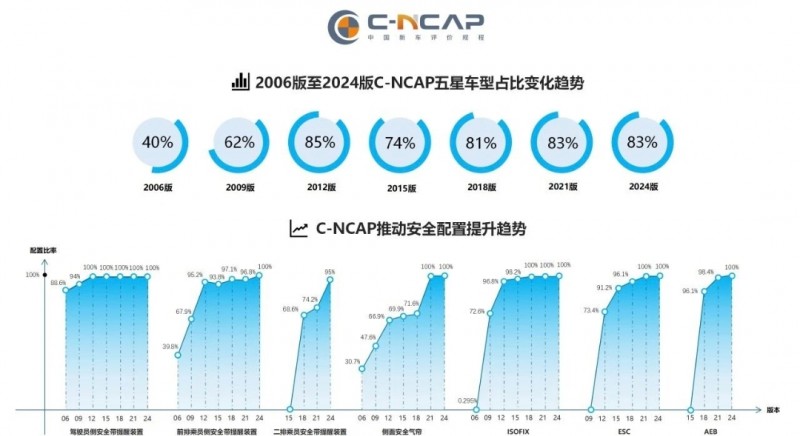Global Collaboration in Automotive Evaluation: Decoding C-NCAP - Reshaping the Safety Genes of Chinese Automobiles
When cars upgrade from mere "means of transportation" to "travel carriers" that meet diverse demands, what force is safeguarding the safety bottom line of this transformation? In October, the 2025 World NCAP Conference will be held in Shanghai, China. Representatives from global NCAP organizations will gather together to explore the future direction of automotive safety. Looking back, the "Chinese solution" for safeguarding travel safety has long been engraved in the 19-year growth trajectory of C-NCAP.
In 2006, the China Automotive Technology and Research Center officially released the China New Car Assessment Program (C-NCAP), filling the gap in the field of automotive safety assessment in China. Over the past 19 years, C-NCAP has not only driven the leapfrog development of China's automotive safety technology with its continuously iterated evaluation system as the "ruler" and scientific and rigorous testing practices as the "foundation", but also deeply reshaped the safety genes of Chinese automobiles.
Key word ①
Build a local security technology yardstick
Since its inception in 2006, C-NCAP has always been in harmony with China's automotive industry. Along with the upgrading of the industry and the iteration of consumers' safety demands, C-NCAP has completed six major upgrades and revisions, gradually establishing a high-standard automotive safety testing and evaluation system that suits China and aligns with international standards. Up to now, C-NCAP has conducted over 1,700 crash tests on 574 popular models from nearly 90 automakers. From the expansion of evaluation dimensions to the upgrading of technical requirements, each version of C-NCAP marks the advanced footprints of Chinese automotive safety. C-NCAP has continuously promoted the safety performance of Chinese automotive products through practice.
Rolling back the clock to 2006, China's automotive industry was in a period of rapid development at that time, but safety technology was relatively lagging behind and safety awareness was still relatively weak. The sudden emergence of C-NCAP not only promotes technological progress with evaluation standards in line with international standards, but also lays a "safe track" for Chinese automakers to participate in global competition. It also provides fair and professional star ratings to offer references for Chinese consumers when choosing and using cars. This move not only initiated the "Chinese practice" of automotive safety assessment, but also ignited the confidence of domestic brands in delving into safety technology, completely reshaping the safety landscape of China's automotive industry.
Key word ②
Promote the full popularization of core safety devices
Over the past 19 years, C-NCAP has always closely followed the global trends in automotive safety technology. With dynamically upgraded test procedures as the "traction device", it has systematically promoted the leapfrog development of China's automotive safety technology. From the 2006 version to the 2024 version, the change in the configuration rate of core safety devices has become the most intuitive "proof of progress".
The configuration rate of side airbags/air curtains has steadily increased from 30.7% in the 2006 version to 100% coverage in the 2021 version. The driver's seat belt unfastened reminder has jumped from an initial configuration rate of less than 90% to a 100% standard configuration for consecutive years. The reminder for unfastened seat belts for front passengers has increased from 39.8% in the 2006 version to 95.2% in the 2012 version, and now it is also 100% equipped. The configuration rate of the child restraint system (ISOFIX) fixtures was less than 30% in the 2006 version. After the implementation of the 2012 version of the regulations, it jumped to over 95%, and after the 2018 version, it was completely 100% standard. The configuration rate of Electronic Stability Control (ESC) in the 2012 version of the regulations was 73.4%, and it has now become a "safety standard" for all vehicle models.

While the core safety devices have been fully popularized, the proportion of C-NCAP five-star models has continued to rise: According to statistics, the proportion of five-star models has jumped from 40% in the 2006 version to 83% in the 2021 version (the 2024 version evaluation is still ongoing). Behind this data lies the leap achieved by Chinese automotive products in three major fields: collision safety, pedestrian protection, and intelligent protection. It further confirms the significant role of C-NCAP in promoting the safety upgrade of the industry.
The nineteen years of C-NCAP have witnessed China's automotive safety technology progress from "catching up" to "keeping pace" and then to partial "taking the lead". Looking to the future, with the further development of intelligent connected and new energy technologies, C-NCAP will, with a more open global perspective and stricter assessment standards, continuously drive automotive safety technology towards the ultimate goal of "zero accidents and zero casualties". This unwavering commitment to the "essence of safety" is not only the core driving force for China's automotive industry to safeguard travel safety, but also the confidence for Chinese auto brands to stand firm globally and win international trust.
